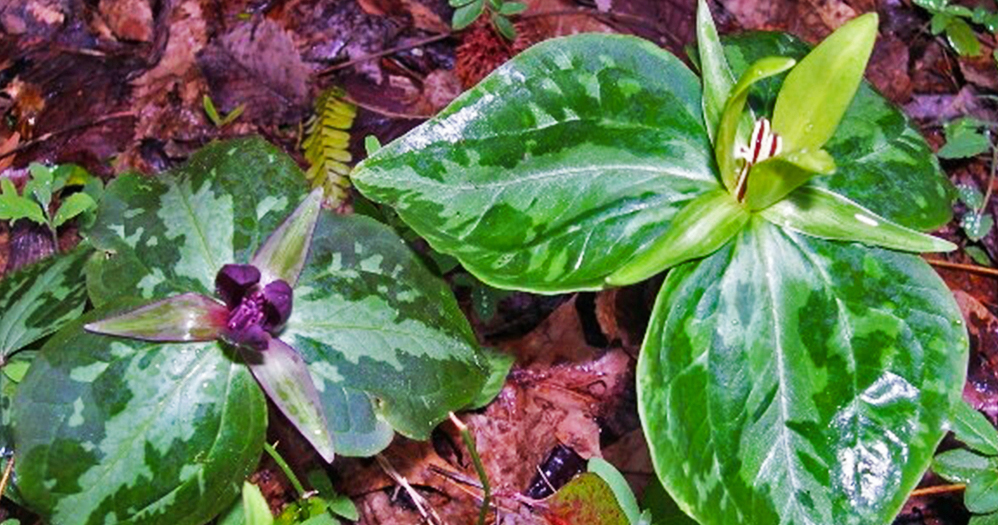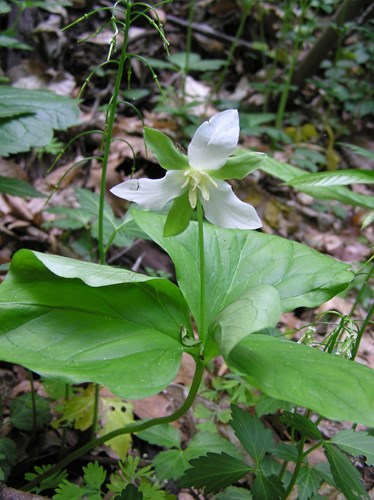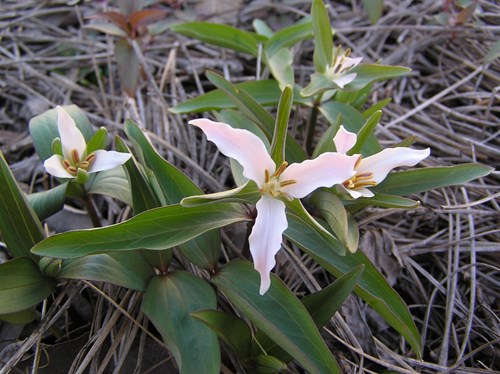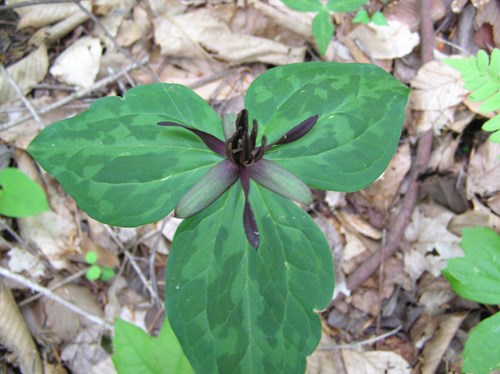Species Portrait: Trillium
5/21/2019 8:32:04 AM
By Amber Floyd, Refuge Manager of Dahomey National Wildlife Refuge

(Trillium cuneatum)
Spring is always an exciting time to take a hike in the woods, with warmer temperatures, gobbling turkeys, and plants emerging from their winter dormancy. Spring ephemerals are a special plant group that are some of the first signs of spring. These perennial plants are found in Mississippi’s deciduous hardwood forests, taking advantage of the ample sunlight that reaches the forest floor in early spring before the trees in the canopy grow new leaves. As hinted by the name, these plants are not in bloom long. They quickly lose their flowers and foliage and return to dormancy under-ground, where their roots store energy until the following spring growing season.

(Trillium flexipies)
Several of Mississippi’s spring ephemerals are found in the genus Trillium. It is easy to remember and recognize Trilliums because their flower arrangements occur in multiples of three. For example, Trilliums feature three flower petals, three sepals, and six stamens. There are no true above-ground leaves; but instead, there are three large leaf-like bracts arranged about a single flower, either born on a short stalk or attached directly to the bracts. Deer and other wildlife browse these plants, as they are some of the first to appear in spring and can disappear entirely in areas with many deer. While they provide a resource for pollinators like flies, beetles, and male mosquitos, they also attractants, which are the primary dispersers of seeds.
Eight species have been documented in Mississippi. They have colorful names that range from Little Sweet Betsy to Bloody Butcher, reflecting both their dainty, un-assuming size and their vivid flowers and foliage. Little Sweet Betsy (Trillium cuneatum), one of the most widely distributed species in the state, usually has deep crimson flowers perched atop three uniform leaves dappled in light and dark green hues. These leaves appear to mimic the light that filters through the canopy and scatters across the forest floor.

(Trillium pusillum)
If left undisturbed, Trilliums can live up to 25 years and take up to seven years to bloom in some areas because of their short growing season. They are great plants to photograph on a hike, but are delicate and can be damaged or even killed by picking the flowers or digging them up. Collecting plants on public lands is usually illegal without a special permit, and, in some areas, these plants are listed as species of concern, so it is best to avoid disturbing them.
You might be tempted to add these spring beauties to your native garden. There are options to purchase cultivated varieties from reputable nurseries. Starting plants from seed can take several years to yield a flowering plant. If you know someone with Trilliums in their garden, it is easier to collect some mature rhizomes in summer or fall while they are dormant to start your planting. Once planted, it can take a year or more before the plant establishes its roots enough to flower, but it will gradually spread if left undisturbed. Although it would seem that Trillium is shade-loving, all plants need sunlight to grow, and some species are merely more tolerant of lower light levels than others. Trillium typically requires at least partial sun while it is actively growing. Having some shade helps maintain the soil moisture needed for them to thrive.

(Trillium stamineum)
A symbol of beauty and renewal, Trillium plants are a welcomed sight in the spring and often can be found in the same habitats as other spring ephemerals, like Jack-in-the-Pulpit and Green Dragon. Like mild spring weather in Mississippi, these plants are not around for long. If you want to see the beautiful flowers and foliage of ephemeral wild-flowers, get out and explore Mississippi’s hardwood forests between early March and mid-May before they are gone.
Amber Floyd is the Refuge Manager of Dahomey National Wildlife Refuge.



